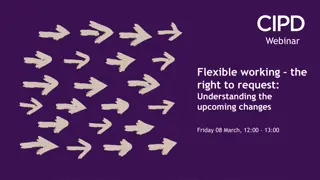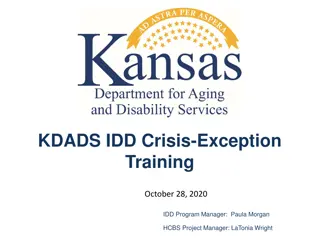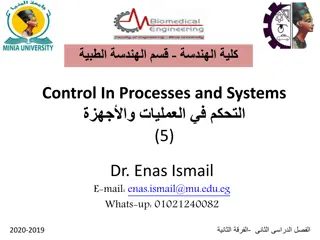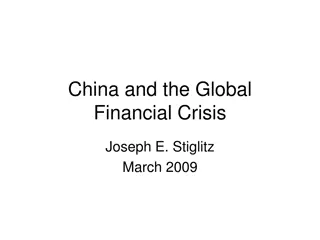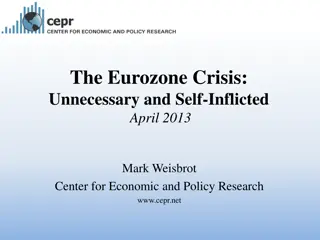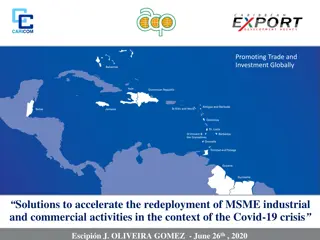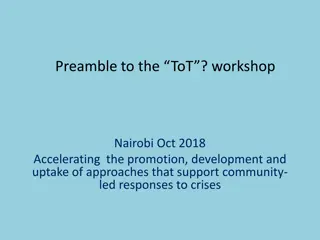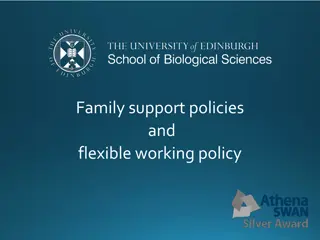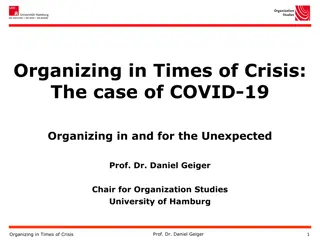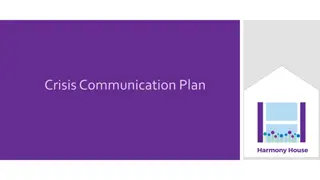Examining Flexible Responses During the Coronavirus Crisis
Local services and systems have rapidly adapted during the COVID-19 pandemic with positive impacts identified. MEAM's research conducted by Cordis Bright examines these flexibilities, their impact on services, systems, and individuals, as well as strategies to maintain these adaptations during the transition phase.
Download Presentation

Please find below an Image/Link to download the presentation.
The content on the website is provided AS IS for your information and personal use only. It may not be sold, licensed, or shared on other websites without obtaining consent from the author. Download presentation by click this link. If you encounter any issues during the download, it is possible that the publisher has removed the file from their server.
E N D
Presentation Transcript
Flexible responses during the Coronavirus crisis (and how to keep them ) Oliver Hilbery, Director, MEAM Research by: Cordis Bright Supported by: The National Lottery Community Fund
Introducing MEAM: A coalition of national charities 1,500 frontline members Formed because people move between sectors and are poorly supported Model the collaboration we want to see from government and services Support over 40 areas across the country to design and deliver better coordinated services Use that knowledge to influence local and national policy 2
Why look at system flexibilities? - Local services and systems have undergone rapid change March to May 2020 - There was anecdotal evidence of positive impact, but little data - MEAM commissioned our evaluators, Cordis Bright, to undertake Rapid Evidence Gathering . - Aim: To inform local area and national government plans for what comes next. 3
What did the research do? 1. Examined the changes made across a range of sectors in last two months 2. Impact on services and systems 3. Impact on people 4. Explored what areas are doing to maintain these flexibilities in the next stage ( transition ) 4
1. Changes across sectors Homelessness: Homelessness: - Emergency accommodation to support the everyone in policy. Substance misuse: Substance misuse: - OST prescriptions covering longer periods of time. Criminal justice: Criminal justice: - Safe accommodation for people released from prison. - Triage based on vulnerability to Covid-19. - Daily virtual contact - Improved partnership working between police and other agencies. - Prescription deliveries to accommodation or local pharmacies. - In-reach provision to the emergency accommodation including from re-deployed services - Continued face-to-face contact. - Rapid assessments. - Restrictions in prison - Continued contact with coordinators and key workers, albeit virtually. - Creating space for physical distancing in existing provision. - Increased flexibility on eligibility. 5
Mental health: Mental health: - Fewer adaptations and less flexibility than other service areas. Women s services: Women s services: - Delivering services remotely. Relationships and working Relationships and working cultures: cultures: - Establishment of new panels or multidisciplinary groups. - Additional funding for domestic abuse services. - Dual diagnosis workers in the emergency accommodation - Increased staff autonomy and flexibility. - Lack of appropriate accommodation. - In-hostel provision of assessments and psychological support, improved discharge planning, and specialist mental health services (all less widespread) Other services: Other services: - Additional support from other community partners, charities and volunteers. - Flexible responses from GPs and partnership working with pharmacies. 6
2. Impact on services and systems Positive: Positive: - Improved inter-agency collaboration and partnership working. - Increased sense of community and shared purpose across agencies. - Working beyond their remit . - Swift decision-making/staff autonomy. - Reflective practice. - Improved relationships with clients - Increased strategic buy-in. - A more supportive and less punitive approach to enforcement. - Identification of gaps in provision. 7
2. Impact on services and systems Positive: Positive: - Improved inter Improved inter- -agency collaboration agency collaboration and partnership working. and partnership working. In general everyone is working more closely together. It s made the relationship between our service and the local authority much closer. - Increased sense of community and shared purpose across agencies. - Working beyond their remit . If people have opened their minds can they close them again? That s the question. Can we really go back? You can t unsee these things once you ve opened them. There s some sort of a sense of comfort from wanting to go back. But really, what we ve been doing before it s just not working. - Swift decision-making/staff autonomy. - Reflective practice. - Improved relationships with clients - Increased strategic buy-in. - A more supportive and less punitive approach to enforcement. - Identification of gaps in provision. 8
2. Impact on services and systems Positive: Positive: - Improved inter-agency collaboration and partnership working. The Covid-19 crisis brought about a shift in the balance of risk: Swift service and policy changes were possible because senior staff had a clear focus on the end goal of making sure people were safe and less interest in the means of doing so, and because senior people did not have capacity to be involved in everything and so trusted staff to get on with it . - Increased sense of community and shared purpose across agencies. - Working beyond their remit . - Swift decision Swift decision- -making/staff autonomy. autonomy. making/staff - Reflective practice. Similarly, the increased autonomy afforded to staff working directly with people facing multiple disadvantage has enabled faster decision-making for clients care. - Improved relationships with clients - Increased strategic buy-in. - A more supportive and less punitive approach to enforcement. - Identification of gaps in provision. 9
2. Impact on services and systems Positive: Positive: - Improved inter-agency collaboration and partnership working. Something has been engendered in people about wanting to make a difference. The response to Covid-19 has been to chuck away the bureaucracy. Suddenly we re having contact with lots of senior people who are taking an interest in our clients, when they didn t before. - Increased sense of community and shared purpose across agencies. - Working beyond their remit . - Swift decision-making/staff autonomy. - Reflective practice. - Improved relationships with clients - Increased strategic buy Increased strategic buy- -in. in. - A more supportive and less punitive approach to enforcement. - Identification of gaps in provision. 10
2. Impact on services and systems Negative: Negative: - Challenge of remote working and new conditions for staff. - Strategic and operational disconnect in planning. - Staff shortages. - Flexibilities due to individuals not systems. - Reduced focus on person-centred care. - Tensions between services in relation to methods of delivery. 11
2. Impact on services and systems Negative: Negative: - Challenge of remote working and new conditions for staff. - Strategic and operational disconnect in planning. Many of the flexibilities are understood to be due to individual workers or interpersonal relationships rather than any long-lasting change in local systems and local areas will need to reflect on this if the flexibilities are to be maintained. - Staff shortages. - Flexibilities due to individuals not Flexibilities due to individuals not systems. systems. - Reduced focus on person-centred care. - Tensions between services in relation to methods of delivery. 12
2. Impact on services and systems Negative: Negative: - Challenge of remote working and new conditions for staff. In some areas local leads reported that there had been a shift towards more doing for people rather than involving people in their own support. Interviews with people with lived experience reflected that they had not been consulted with regards to the provision of their support during this time. - Strategic and operational disconnect in planning. - Staff shortages. - Flexibilities due to individuals not systems. - Reduced focus on person Reduced focus on person- -centred care. centred care. - Tensions between services in relation to methods of delivery. 13
3. Impact on people Positive: Positive: - Clients adapting and engaging well. - Safe and sustained accommodation placements. - Increased autonomy. - Increased trust in individuals and services. - Increased engagement with substance misuse services. - Effective self-management of medication. - Positive mental health outcomes for some people where additional and appropriate support is available. 14
3. Impact on people Positive: Positive: - Clients adapting and engaging well. Clients adapting and engaging well. Local leads reported that a large number of clients had adapted well to their new circumstances, were engaging with more services and had displayed considerable resilience. For some staff, this had been a surprise and had made them think that perhaps services had tended to do for people to a greater extent than was actually necessary. - Safe and sustained accommodation placements. - Increased autonomy. - Increased trust in individuals and services. - Increased engagement with substance misuse services. - Effective self-management of medication. - Positive mental health outcomes for some people where additional and appropriate support is available. 15
3. Impact on people Positive: Positive: - Clients adapting and engaging well. Clients trust in their support workers and other services has increased as a result of them having stuck with them throughout this crisis period. While the provision of remote support was less than ideal for many clients, the consistent contact from support workers had a positive impact on their trust in these services. - Safe and sustained accommodation placements. - Increased autonomy. - Increased trust in individuals and Increased trust in individuals and services. services. - Increased engagement with substance misuse services. - Effective self-management of medication. - Positive mental health outcomes for some people where additional and appropriate support is available. 16
3. Impact on people Positive: Positive: - Clients adapting and engaging well. In the minority of areas where successful adaptations and flexibilities were implemented by mental health services, people were reported to be experiencing improvements in their mental health. - Safe and sustained accommodation placements. - Increased autonomy. - Increased trust in individuals and services. - Increased engagement with substance misuse services. - Effective self-management of medication. - Positive mental health outcomes for Positive mental health outcomes for some people where additional and some people where additional and appropriate support is available. appropriate support is available. 17
3. Impact on people Negative: Negative: - Knock back to progress. - Loss of meaningful activity - Less positive experiences of emergency accommodation. - Challenges of engaging in remote support. - Stalling of progress due to reduced or different access to services. - Risk to some substance misuse service users. - Exclusion of vulnerable people who are not verified as rough sleeping. - Social isolation, anxiety and poor mental health. 18
3. Impact on people Negative: Negative: - Knock back to progress. Knock back to progress. I have worked really hard to set myself up with lots of activities to keep me occupied and away from drugs, and I m now struggling that I cannot do most of these activities [...] - Loss of meaningful activity - Less positive experiences of emergency accommodation. - Challenges of engaging in remote support. - Stalling of progress due to reduced or different access to services. - Risk to some substance misuse service users. - Exclusion of vulnerable people who are not verified as rough sleeping. - Social isolation, anxiety and poor mental health. 19
3. Impact on people Negative: Negative: - Knock back to progress. Reasons suggested for less positive experiences include: Lower support levels in hostels; staff shortages; emergency accommodation not being appropriate or staff not being appropriately trained; co- location of large numbers of residents into one hostel or hotel" - Loss of meaningful activity - Less positive experiences of emergency Less positive experiences of emergency accommodation. accommodation. - Challenges of engaging in remote support. - Stalling of progress due to reduced or different access to services. - Risk to some substance misuse service users. - Exclusion of vulnerable people who are not verified as rough sleeping. - Social isolation, anxiety and poor mental health. 20
3. Impact on people Negative: Negative: - Knock back to progress. I don t like to do [support] over the phone. I like to see people. It s affecting me this has really affected me. [ ] It s made me cry every day. I feel like now I ve got no friends whatsoever. I don t see anybody. The only people I used to see were my workers, and other peers in my group. I feel alone. - Loss of meaningful activity - Less positive experiences of emergency accommodation. - Challenges of engaging in remote Challenges of engaging in remote support. support. - Stalling of progress due to reduced or different access to services. - Risk to some substance misuse service users. - Exclusion of vulnerable people who are not verified as rough sleeping. - Social isolation, anxiety and poor mental health. 21
4. Planning for transition - Learning and reflection: Learning and reflection: - Most respondents were confident that their areas were taking the opportunity to learn and reflect (but couldn t always point to it!) - Planning to maintain flexibilities: Planning to maintain flexibilities: - Leadership on transition planning coming mainly from housing, less evidence of wider cross-sector planning. - Little evidence of involvement of people with lived experience - A positive feeling that collaboration would have to continue. - Challenges Challenges - Funding and timescales - A worry about return to the status quo 22
What can you do? - Does your area have a forum in place to learn and reflect on the flexibilities currently in place? - Does your area have the cross-sector leadership needed to maintain some of the positive flexibilities into the future? - Do you have processes in place to involve people with lived experience in your transition planning? Download Rapid Evidence report from tomorrow: www.meam.org.uk MEAM transition framework: http://meam.org.uk/wp- content/uploads/2020/05/Framework-transition-planning-v1.pdf 23
Thank you: oliver.hilbery@meam.org.uk www.meam.org.uk @meamcoalition #multipledisadvantage 24




